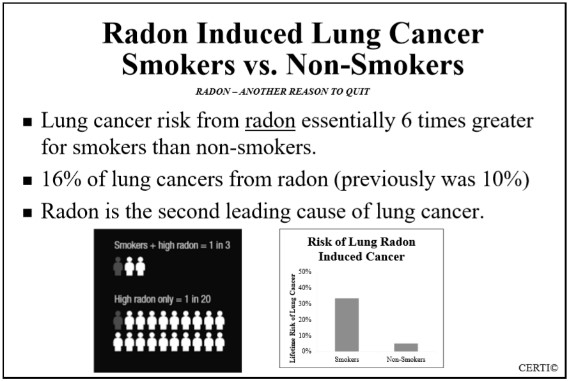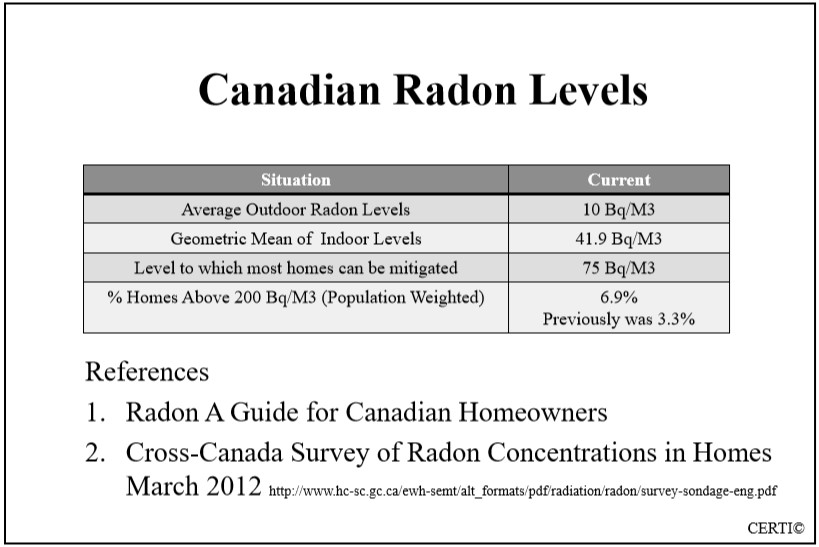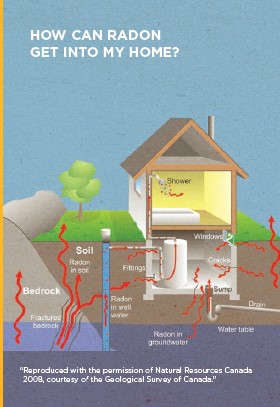Radon has been called the silent killer that most people do not know about. In her book called “Radon should be on your radar”, Author Kim Roy speaks of a hidden danger lurking in your homes that most of us probably never heard about. It is called Radon. So, what is it? What is Radon?
It is an invisible, TOXIC, odorless, tasteless, radioactive noble gas. It occurs naturally when uranium (radioactive element) in the soil and rocks break down. It is formed by the disintegration of radium (radioactive element), a decay product of uranium. When radon is released from the ground into the outdoor air, it is diluted and is not a concern. However, in enclosed spaces like homes, it can accumulate to high levels. High radon levels can be a risk to the health of you and your family.
Radon produces several solid radioactive products called radon daughters or “progeny”.
Some amounts of radon gas are present naturally everywhere in the soil, water, and air. However, high radon levels occur in regions predictably where the soil or rock is rich in uranium. It can enter the indoor air where it (and its progeny) can accumulate in poorly ventilated areas.
Radon progeny are inhaled with air and deposited in the lungs. The lung absorbs alpha particles emitted by the radon progeny. The resulting radiation dose increases the risk of lung cancer.
The following figure (Figure 1) illustrates the radioactive decay chain that produces radon and radon progeny.
Figure 1. Production of radon and radon progeny from uranium

What is the danger present in inhaling Radon? Is it true I can get cancer from radon exposure?
Radon can quickly disintegrate into other radioactive elements in our lungs after inhalation. It is the second most prevalent cause of lung cancer in the Americas (including Canada and the United States) after smoking.
An estimated 1 in 3 smokers will be susceptible to lung cancer due to radon inhalation and 1 in 20 non-smokers are susceptible to lung cancer due to radon inhalation. This is an alarming statistic and needs to be addressed at the source.
Figure 2. Annual Deaths in Canada from Radon compared to others

Figure 3. Annual Deaths in Canada from Radon compared to others

What are units of measurement of Radon Gas? What is the current guideline for Radon in indoor air?
Since radon is a product of radioactive decay, the units of measurement are Bq/m3 (Becquerel/m3, Becquerel named after Henri Becquerel is a unit denoting Radioactive decays per second) or pCi/L which is (Pico-Curie per liter). The Radon mitigation standards developed by the EPA require that the concentration in indoor spaces do not exceed 4 pCi/L. 1 pCi/L equals 37 Bq/m3. The Canadian standard for Radon levels is 200 Bq/m3. Most homes can be mitigated below 75 Bq/m3
Figure 4. Canada Radon Levels

Acceptable levels of radon in “dwellings” which include homes or public buildings (schools, hospitals, long-term care facilities and correctional facilities) are 200 Becquerels per cubic meter (200 Bq/m3) based on the Government of Canada Radon Guidelines
How does Radon enter my building or house?
Radium in the soil directly under a building is normally the major source of indoor radon. Other sources of radium are in groundwater and building materials.
The presence of uranium in soil and rock is an important indicator of places where radium and radon can be present. Because radon is a gas, a fraction of the radon produced in the soil can find its way into a building. The rest is trapped in the soil. In the air, radon decays to radon progeny that are solids, and are present in the building air as fine particles.
The concentration of radon and radon progeny in the indoor air depends on:
- the amount of radium in the soil and
- the ease with which the radon it produces can move through soil and building walls where it can then mix with the room air.
- Soil pressure with respect to ambient air pressure
Changes in atmospheric pressure can also affect its emission from the ground and its accumulation in the building air.
The concrete floor and walls in the basement slow down the movement of radon from the soil into the building. However, cracks in the floor, wall slab joints, and the drainage system allow radon to enter a building.
Indoor radon concentrations are almost always higher than outdoor concentrations. Once inside a building, the radon cannot easily escape. The sealing of buildings to conserve energy reduces the intake of outside air and worsens the situation. Radon levels are generally highest in cellars and basements because these areas are nearest to the source and are usually poorly ventilated.
Figure 5. How can radon get into my home?

How do I find out if there is radon in my basement?
Contact a radon mitigation professional today to determine if radon should be on top of your mind. Certified Radon testing professionals can help you determine the radon levels in your basement, home, and building. The Canadian National Radon Proficiency Program (C-NRPP) provides courses and training which helps certified professionals to test and provide a design for mitigation of high Radon levels. If Radon levels are higher than 200 – 600 Bq/m3, immediate steps must be taken to mitigate the radon levels through an ASD (Active Slab depressurization) system which involves the installation of underground piping, a suction pit and an active vent fan as its major components. This will redirect the radon through the fan safely into the atmosphere, preventing it from entering your homes
How to mitigate radon entry into my space?
In Alberta, Radon was identified as a risk to building occupants as late as 2014 when the Alberta Building Code was updated to include the measures needed to identify and mitigate the sources through which radon can infiltrate into your building space. There are three methods of mitigating the effect of radon infiltration into the space and a combination of these three methods can be applied to effectively negate the radon that infiltrates into our living spaces.
The methods are:
- Building Pressurization
- Sub Slab Depressurization through Active and Passive Methods
- Sealing
Where do we go from here?
The best way to help is to understand the severity of the problem we are facing and conduct valid and intelligent research with the correct framework of knowledge to mitigate the problem at hand. With the experience, data, and body of knowledge that we possess, Lexus Engineering can advise you on the mitigation measures necessary to make your building and home a safe place to live.
References:
1. Alberta Building Code 2014
2. U.S. Environmental Protection Agency, U.S. Department of Health and Human Services, and U.S. Public Health Service. Radon Prevention in the Design and Construction of Schools and Other Large Buildings, June 1994
3. U.S. Environmental Protection Agency, U.S. Department of Health and Human Services, and U.S. Public Health Service. Radon Mitigation Standards, June 1994
4. U.S. Environmental Protection Agency, U.S. Department of Health and Human Services, and U.S. Public Health Service. Sub Slab Depressurization for a Low Permeability Fill, Design and Installation of a Home Radon Reduction System, July 1991
